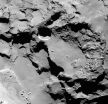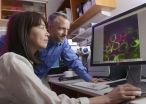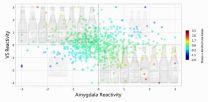(Press-News.org) The European Space Agency's Rosetta spacecraft first began orbiting comet 67P/Churyumov-Gerasimenko in August 2014. Almost immediately, scientists began to wonder about several surprisingly deep, almost perfectly circular pits on the comet's surface. Now, a new study based on close-up imagery taken by Rosetta suggests that these pits are sinkholes, formed when ices beneath the comet's surface sublimate, or turn directly to gas.
The study, which appears in the July 2, 2015 issue of the journal Nature, reveals that the surface of 67P/Churyumov-Gerasimenko is variable and dynamic, undergoing rapid structural changes as it approaches the sun. Far from simple balls of ice and dust, comets have their own life cycles. The latest findings are among the first to show, in detail, how comets change over time.
"These strange, circular pits are just as deep as they are wide. Rosetta can peer right into them," said Dennis Bodewits, an assistant research scientist in astronomy at the University of Maryland who is a co-author on the study. The pits are large, ranging from tens of meters in diameter up to several hundred meters across.
"We propose that they are sinkholes, formed by a surface collapse process very similar to the way sinkholes form here on Earth," Bodewits added. Sinkholes occur on Earth when subsurface erosion removes a large amount of material beneath the surface, creating a cavern. Eventually the ceiling of the cavern will collapse under its own weight, leaving a sinkhole behind. "So we already have a library of information to help us understand how this process works, which allows us to use these pits to study what lies under the comet's surface," Bodewits said.
Bodewits and his co-authors analyzed images from Rosetta's Optical, Spectroscopic and Infrared Remote Imaging System (OSIRIS) narrow angle camera, which is designed to image the surface of the comet's nucleus. The team noted two distinct types of pits: deep ones with steep sides and shallower pits that more closely resemble those seen on other comets, such as 9P/Tempel 1 and 81P/Wild. The team also observed that jets of gas and dust streamed from the sides of the deep, steep-sided pits --a phenomenon they did not see in the shallower pits.
Initially, the Rosetta team suspected that discrete, explosive events might be responsible for creating the deeper pits. Rosetta observed one such outburst during its approach to the comet, on April 30, 2014. Catching this event in the act allowed the team to quantify how much material had been ejected, and it quickly became obvious that the numbers just didn't stack up. Explosive outbursts alone could not explain the formation of these giant pits.
"The amount of material from the outburst was large--about 100,000 kilograms--but this is small compared to the size of the comet and could only explain a hole a couple of meters in diameter," Bodewits explained. "The pits we see are much larger. It seems that outbursts aren't driving the process, but instead are one of the consequences."
Based on the Rosetta observations, the team has proposed a model for the formation of these sinkholes. A source of heat beneath the comet's surface causes ices (primarily water, carbon monoxide and carbon dioxide) to sublimate. The voids created by the loss of these ice chunks eventually grow large enough that their ceilings collapse under their own weight, giving rise to the deep, steep-sided circular pits seen on the surface of comet 67P/Churyumov-Gerasimenko.
The collapse exposes comet ices to sunlight for the first time, which causes the ice chunks to begin sublimating immediately. These deeper pits are therefore thought to be relatively young. Their shallower counterparts, on the other hand, are most likely older sinkholes with more thoroughly eroded sidewalls and bottoms that have been filled in by dust and ice chunks.
"In some sense, these deep sinkholes remind me of the crater excavated on comet Tempel I by the Deep Impact mission," said Michael A'Hearn, a Distinguished University Professor Emeritus of astronomy at UMD and a co-author on the study. A'Hearn also served as principal investigator on the Deep Impact mission, which coincidentally celebrates its ten-year anniversary this summer. "The process is completely different, of course, but both allow us to achieve the same broad goal of being able to see deeper into a comet."
The European Space Agency officially extended the Rosetta mission on June 23, 2015, meaning that the spacecraft will have the opportunity to track comet 67P/Churyumov-Gerasimenko for a much longer time period as it moves away from the sun. The comet will reach perihelion, or its closest point to the sun, on August 13, 2015. The extension expands the mission by nine months, from the planned end date of December 2015 to September 2016. The extra observational time will enable the team to see how the comet's surface responds to decreasing solar radiation.
INFORMATION:
The Rosetta mission is operated by the European Space Agency with national agencies funding the instrumentation and scientific activities. University of Maryland participation in the OSIRIS camera team is funded by NASA's Jet Propulsion Laboratory (Contract # 1267923) and a Gauss Professorship from the Göttingen Academy of Sciences (to Michael A'Hearn). The content of this article does not necessarily reflect the views of these organizations.
The research paper, "Large heterogeneities in comet 67P as revealed by active pits from sinkhole collapse," Jean-Baptiste Vincent, et al., was published in the July 2, 2015 issue of the journal Nature.
Media Relations Contact: Matthew Wright, 301-405-9267, mewright@umd.edu
University of Maryland
College of Computer, Mathematical, and Natural Sciences
2300 Symons Hall
College Park, MD 20742
http://www.cmns.umd.edu
@UMDscience
About the College of Computer, Mathematical, and Natural Sciences
The College of Computer, Mathematical, and Natural Sciences at the University of Maryland educates more than 7,000 future scientific leaders in its undergraduate and graduate programs each year. The college's 10 departments and more than a dozen interdisciplinary research centers foster scientific discovery with annual sponsored research funding exceeding $150 million.
DALLAS - July 1, 2015 - UT Southwestern Medical Center scientists collaborating with University of Michigan researchers have found a previously unidentified mechanism that helps explain why stem cells undergo self-renewing divisions but their offspring do not.
Adult stem cells provide a ready supply of new cells needed for tissue homeostasis throughout the life of an organism. Specialized environments called "niches" help to maintain stem cells in an undifferentiated and self-renewing state. Cells that comprise the niche produce signals and growth factors essential for ...
DURHAM, N.C. - A pair of brain-imaging studies suggest researchers may be able to predict how likely young adults are to develop problem drinking or engage in risky sexual behavior in response to stress.
The new research is part of the ongoing Duke Neurogenetics Study (DNS), which began in 2010 to better understand how interactions between the brain, genome and environment shape risky behaviors that can predict mental illnesses including depression, anxiety, and addiction.
"By knowing the biology that predicts risk, we hope to eventually change the biology -- or at ...
GeoSpace
Beijing quadrupled in size in a decade, new study finds
Researchers tracked the changing physical infrastructure in Beijing, China, and found that the city's physical area quadrupled between 2000 and 2009, according to a new study published in Journal of Geophysical Research: Atmospheres.
Eos.org
Seismic Hazard Assessment: Honing the Debate, Testing the Models
Earthquake experts learn that "take a hike" isn't an insult, but a way to resolve hotly debated scientific issues. The scientists found common ground by trekking over it.
New research papers
Disappearance ...
For decades, researchers in the genetics field have theorized that the protein spools around which DNA is wound, histones, remain constant in the brain, never changing after development in the womb. Now, researchers from the Icahn School of Medicine at Mount Sinai have discovered that histones are steadily replaced in brain cells throughout life - a process which helps to switch genes on and off. This histone replacement, known as turnover, enables our genetic machinery to adapt to our environment by prompting gene expression, the conversion of genes into the proteins that ...
Washington, D.C., July 1, 2015--The vast majority of consumers recognize that multivitamins, calcium and/or vitamin D supplements can help fill nutrient gaps but should not be viewed as replacements for a healthy diet, according to a new survey conducted on behalf of the Council for Responsible Nutrition (CRN). Conclusions from the survey of more than 2,000 U.S. adults were published in Nutrition Journal in a peer-reviewed article titled, "Consumer attitudes about the role of multivitamins and other dietary supplements: report of a survey," authored by CRN consultant Annette ...
Neurons in a brain region called the medial temporal lobe play a key role in our ability to quickly form memories about real-life events and experiences, according to a study published July 1st in Neuron. By recording from individual neurons in patients, the researchers reveal for the first time in humans the single-cell basis for the creation of episodic memories.
"It was impressive to see how individual neurons signalled the learning of new contextual associations between people and places and that the changes in firing could occur just after one instance," says lead ...
The brain region that helps people tell whether an object is near or far may also guide how emotionally close they feel to others and how they rank them socially, according to a study conducted at the Icahn School of Medicine at Mount Sinai and published today in the journal Neuron. The findings promise to yield new insights into the social deficits that accompany psychiatric disorders like schizophrenia and depression.
The study focused on evidence for the existence of a "social map" in the hippocampus, the part of the brain that remembers locations in physical space ...
If your eyes deceive you, blame your brain. Many optical illusions work because what we see clashes with what we expect to see.
That 3D movie? Give credit to filmmakers who exploit binocular vision, or the way the brain merges the slightly different images from the two eyes to create depth.
These are examples of the brain making sense of the information coming from the eyes in order to produce what we "see." The brain combines signals that reach your retina with the models your brain has learned to predict what to expect when you move through the world. Your brain solves ...
Neurons are a limited commodity; each of us goes through life with essentially the same set we had at birth. But these cells, whose electrical signals drive our thoughts, perceptions, and actions, are anything but static. They change and adapt in response to experience throughout our lifetimes, a process better known as learning.
Research conducted at The Rockefeller University and collaborating institutions has uncovered a new mechanism that makes this plasticity possible. This discovery centers on a specific type of histone, proteins that support DNA and help control ...
WASHINGTON (July 1, 2015) -- Researchers at the George Washington University (GW), led by Michael S. Irwig, M.D., found that men referred for tertiary care for borderline testosterone levels had much higher rates of depression and depressive symptoms than those of the general population.
"In an era where more and more men are being tested for "Low T" -- or lower levels of testosterone -- there is very little data about the men who have borderline low testosterone levels," said Irwig, associate professor of medicine and director of the Center for Andrology at the GW School ...





